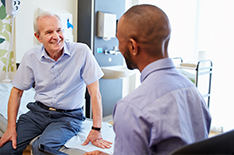Introduction
This policy is designed to protect both patients and staff from abuse or allegations of abuse and to assist patients to make an informed choice about their examinations and consultations.
Guidelines
Clinicians (male and female) should consider whether an intimate or personal examination of the patient (either male or female) is justified, or whether the nature of the consultation poses a risk of misunderstanding.
- The clinician should give the patient a clear explanation of what the examination will involve.
- Always adopt a professional and considerate manner – be careful with humour as a way of relaxing a nervous situation as it can easily be misinterpreted.
- Always ensure that the patient is provided with adequate privacy to undress and dress.
- Ensure that a suitable sign is clearly on display in each consulting or treatment room offering the chaperone service if required.
This should remove the potential for misunderstanding. However, there will still be times when either the clinician, or the patient, feels uncomfortable, and it would be appropriate to consider using a chaperone. Patients who request a chaperone should never be examined without a chaperone being present. If necessary, where a chaperone is not available, the consultation/examination should be rearranged for a mutually convenient time when a chaperone can be present.
Complaints and claims have not been limited to male doctors with female patients – there are many examples of alleged homosexual assault by female and male doctors. Consideration should also be given to the possibility of a malicious accusation by a patient.
Who Can Act as a Chaperone?
A variety of people can act as a chaperone in the practice. Where possible, it is strongly recommended that chaperones should be clinical staff familiar with procedural aspects of personal examination.
At The Old Court House Surgery, some non-clinical staff (receptionists) have been trained to perform the role of chaperone and will wear a green tabard embroidered with the word “Chaparone” to identify themselves as such when performing this role. The training has included the procedural aspects of personal examinations and the scope and extent of the role. The patient must agree to the presence of a non-clinician in the examination, and be at ease with this.
Confidentiality
- The chaperone should only be present for the examination itself, and most discussion with the patient should take place while the chaperone is not present.
- Patients should be reassured that all practice staff understand their responsibility not to divulge confidential information.
Procedure
- The clinician will contact reception to request a chaperone.
- Where no chaperone is available, a clinician may offer to delay the examination to a date when one will be available, as long as the delay would not have an adverse effect on the patient’s health.
- If a clinician wishes to conduct an examination with a chaperone present but the patient does not agree to this, the clinician must clearly explain why they want a chaperone to be present. The clinician may choose to consider referring the patient to a colleague who would be willing to examine them without a chaperone, as long as the delay would not have an adverse effect on the patient’s health.
- The clinician will record in the notes that the chaperone is present, and identify the chaperone.
- The chaperone will enter the room discreetly, identify themselves as a “trained chaperone” if a non-clinical member of staff, and remain in the room until the clinician has finished the examination.
- The chaperone will normally attend inside the curtain at the head of the examination couch and watch the procedure. It is important that the chaperone remain alert to verbal and non-verbal indications of distress from the patient.
- To prevent embarrassment, the chaperone should not enter into conversation with the patient or GP unless requested to do so, or make any mention of the consultation afterwards.
- The patient can refuse a chaperone, and if so this must be recorded in the patient’s medical record.
- The chaperone may enter information regarding the examination onto the patient records if it is deemed appropriate to do so.






